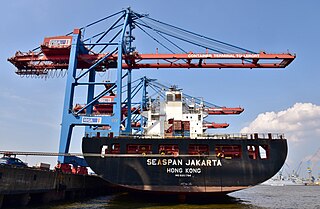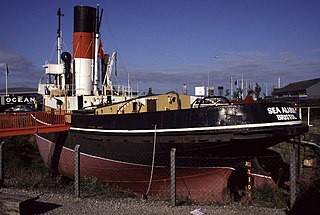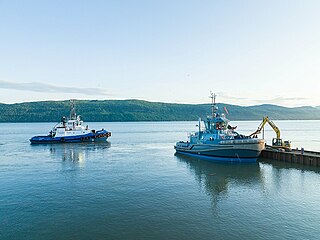
A fireboat or fire-float is a specialized watercraft with pumps and nozzles designed for fighting shoreline and shipboard fires. The first fireboats, dating to the late 18th century, were tugboats, retrofitted with firefighting equipment. Older designs derived from tugboats and modern fireboats more closely resembling seafaring ships can both be found in service today. Some departments would give their multi-purpose craft the title of "fireboat" also.

The Orca-class patrol vessels are a class of eight steel-hulled training and surveillance vessels in service with the Royal Canadian Navy (RCN) at Patrol Craft Training Unit (PCTU) Canadian Forces Base (CFB) Esquimalt. Based on the Australian Pacific-class patrol boat design, all of the Orca vessels were constructed by Victoria Shipyards between November 2004 and November 2008. In addition to carrying the RCN designation of patrol craft training (PCT), the Orca class are not formally commissioned in the RCN and as such do not possess the His Majesty's Canadian Ship (HMCS) prefix.

Canadian Forces Base Esquimalt is Canada's Pacific Coast naval base and home port to Maritime Forces Pacific and Joint Task Force Pacific Headquarters. As of 2018, 4,411 military personnel and 2,762 civilians work at CFB Esquimalt.

Seaspan ULC provides marine-related services to the Pacific Northwest. Within the Group are three shipyards, an intermodal ferry and car float business, along with a tug and barge transportation company that serves both domestic and international markets. Seaspan, is part of the Washington Companies that are owned by Dennis Washington. Kyle Washington, is the Executive Chairman of Seaspan, who has become a Canadian citizen.
The Protecteur class of naval auxiliaries for the Royal Canadian Navy (RCN) began as the Joint Support Ship Project, a Government of Canada procurement project for the RCN that is part of the National Shipbuilding Procurement Strategy. It will see the RCN acquire two multi-role vessels to replace the earlier Protecteur-class auxiliary oiler replenishment vessels.

Hoga (YT-146/YTB-146/YTM-146) is a United States Navy Woban-class district harbor tug named after the Sioux Indian word for "fish." After World War II, the tug was known as Port of Oakland and then City of Oakland when she was a fireboat in Oakland, California.

William Lyon Mackenzie, is a fireboat operated by Toronto Fire Services (TFS) which provides marine fire fighting and icebreaking capabilities within the Toronto Harbour. Built by Russel Brothers in 1964, it is named after William Lyon Mackenzie, the first mayor of Toronto. In 2004 the fireboat was refurbished and it is expected to be in service until 2037.
The Royal Canadian Navy uses hull classification symbols to identify the types of its ships, which are similar to the United States Navy's hull classification symbol system. The Royal Navy and some European and Commonwealth navies use a somewhat analogous system of pennant numbers.

A net laying ship, also known as a net layer, net tender, gate ship or boom defence vessel was a type of naval auxiliary ship.
CFAV Tillicum is a harbour tug of the Queen`s Harbour Master. She is stationed at CFB Esquimalt, on Vancouver Island.

The Ville-class harbour tugboats are a class of tugboats employed by the Royal Canadian Navy.

CFAV Firebrand is a Fire-class fireboat in the Royal Canadian Navy designed by Robert Allan Ltd. Firebrand is based in CFB Esquimalt, on Vancouver Island. Her sister ship CFAV Firebird was based in CFB Halifax and decommissioned in 2014.

CFAV Firebird was a Fire-class fireboat in the Royal Canadian Navy designed by Robert Allan Ltd. Firebird was based in CFB Halifax, in Halifax, Nova Scotia. Her sister ship CFAV Firebrand is based in CFB Esquimalt.

Forceful was a sea-going tugboat built for the Queensland Tug Company by Alexander Stephen and Sons Ltd in Govan, Scotland in 1925. She worked at her homeport of Brisbane, Australia between 1926 and 1970 berthing ships and assisting nearby casualties. During World War II she was commissioned into the Royal Australian Navy in early 1942 as HMAS Forceful (W126), based at Fremantle and Darwin, until returning to commercial service in October 1943. She was preserved as a museum ship until 2023 when she was scrapped.

The Fire-class fireboats/yard tractor tugs were two fireboats operated by the Royal Canadian Navy. The two vessels are CFAV Firebrand (YTR 562) and CFAV Firebird (YTR 561).

Admiralty tugs were tugboats built for and operated by the Royal Navy. These were vessels built to Admiralty specifications and in specific classes during the First and Second World Wars. They were built to meet the Royal Navy's demand for auxiliary vessels and to supplement the civilian tugs requisitioned by the Admiralty for war service.

Although it is a busy port, there is sparse record of fireboats in Halifax, Nova Scotia.

Splinter fleet or Splinter navy was a nickname given to the United States wooden boats used in World War II. The boats served in many different roles during the war. These boats were built in small boatyards on the West coast and East coast, Great Lakes and the Gulf of Mexico. They could be built quickly, in just 60 to 120 days. Most of the boats were built by boatyards that already had the tools and knowledge from building yachts, sailboats and motor boats. Many were built by craftsmen in family-owned small businesses. Under the Emergency Shipbuilding Program and War Shipping Administration contracts went out to over fifty boatyards across the country. The boats were built for the US Navy, the United States Army Air Forces, United States Coast Guard, and US Army. Some of the wooden boats went to Allied nations on the Lend-Lease program.

The Naval Large Tugboat is a class of naval tugboat operated by the Royal Canadian Navy. Four Naval Large Tugboats (NLT) are being built by Ocean Industries Inc. of L'Isle-aux-Coudres under the National Shipbuilding Strategy. The first two tugboats will be based at CFB Esquimalt, and last two will be based at CFB Halifax. The steel cutting for the first NLT commenced in September 2020 and the lead ship, CFAV Haro, was launched on 15 July 2022.














